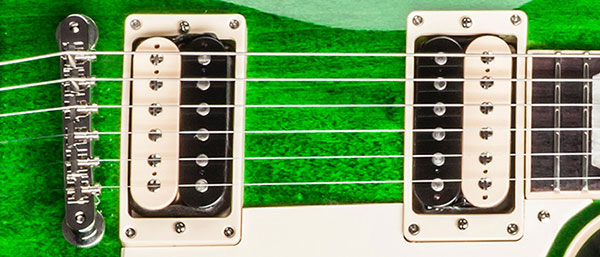You can check out the spec of new 2017 Gibson Les Pauls now. But wait! Maybe you need a renowned guitar expert to talk you the models? And that’s good, because that’s exactly what Harmony Central’s Craig Anderton is doing for you!
In a new article at Harmony Central, Craig looks “under the hood” of the Les Paul Classic and what makes it different from the Les Paul Traditional. Differences you may not immediately see with your eye, but differences you’ll want to know. And will feel and hear.

Classic vs Traditional?
As Anderton notes, “Classic” has a vintage ring to it, and this Les Paul [Classic] does indeed have a traditional flavor. However, there are several elements that differentiate it from the Traditional model.”
He starts by explaining the things in common: hand-wired electronics, leaf-style “springy” pickup toggle switch and Switchcraft output jack, Orange Drop capacitors in the tone control circuitry... The Classic’s nut is nylon, it has a nickel-plated ABR bridge/aluminum stop piece, and nickel plating also for that more vintage look. “But dig deeper,” on the Classic, and he writes, “you’ll find several differences that help make it more of a streamlined ‘workhorse’ guitar for today’s guitarists. Just some of the features he pinpoints:
Classic 9-hole weight relief: “This helps shave off some weight, adds a little resonance, and has virtually no impact on sustain.”
The neck: “The Classic has a SlimTaper profile, which some players (especially those with smaller hands) find more comfortable. It has a more “modern” feel compared to the Traditional, and is more like the kind of neck taper associated with post-’50s guitars. It also has rolled fretboard edges that complement the slimmer neck’s comfort factor.”

Grover locking tuners: “While they may not have a ‘vintage’ look, they are designed to fit well with the Classic’s overall design aesthetic.”
Pickguard: “The Classic comes with a pick guard already in place; it’s not removable like on the HP line of guitars.”
Pickups: “ This is where I heard the biggest sonic difference compared to the Traditional... The pickups are higher in overall output than the Traditional models—the sound is something you’d associate more with the ‘60s than the ‘50s.”

Knobs: Anderton likes the Classic’s speed knobs for practicality, even though the Traditional’s “Top Hat knobs “have a lot of sentimental value.”
The top: He notes that the Classic has a plain top as opposed to the Traditional’s rare, highly-figured top. It won’t change your sound, but as an aesthetic, it’s one of the first things you may have in mind. Or, rather, your eyes.
One Player’s Verdict?
Classic or Traditional is just one choice you can make, but Anderton reckons, “My take is that the Classic is about being inspired by the Traditional’s heritage, but without feeling a need to re-create the past—hence weight relief, a slimmer neck, and hotter pickups. Guitarists with one foot in the ‘50s and one in the ‘70s will probably find the Classic the best fit for their playing style.”
Read the full Gibson Les Paul Classic overview.
See the full range of Gibson USA 2017 models.
Craig Anderton’s overviews at Harmony Central are a must read when it comes to choosing your 2017 Gibson Les Paul. Also in his the series of features on the 2017 Gibson Guitars, you’ll find:
What Makes A Les Paul Traditional Guitar "Traditional"?
How The Les Paul Tribute Pays Tribute
Brothers in Arms - The Les Paul Studio and Standard
Craig Anderton is Editorial Director of Harmony Central. Harmony Central is part of Gibson Brands.






